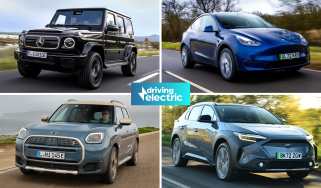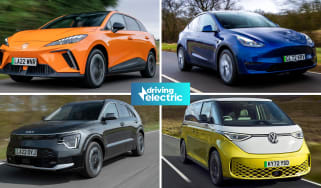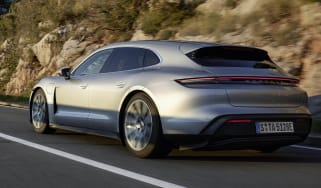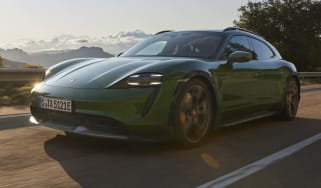Porsche Taycan Cross Turismo review
The Taycan Cross Turismo is as sharp and engaging as its saloon sibling, but adds practicality for a more rounded package
Pros
- Added practicality
- Driver engagement
- Potent performance
Cons
- Shorter range than some rivals
- Expensive options list
- No rear-wheel-drive version
| Model | Range | Wallbox charge time | Rapid charge time |
|---|---|---|---|
| Taycan 4 | 304 miles | 13hrs 30mins (0-100%, 7.4kW) | 23mins (5-80%, 270kW) |
| Taycan 4S | 304 miles | 13hrs 30mins (0-100%, 7.4kW) | 23mins (5-80%, 270kW) |
| Taycan Turbo | 301 miles | 13hrs 30mins (0-100%, 7.4kW) | 23mins (5-80%, 270kW) |
| Taycan Turbo S | 285 miles | 13hrs 30mins (0-100%, 7.4kW) | 23mins (5-80%, 270kW) |
Porsche proved something to the automotive world with the Taycan, demonstrating that the electric-car revolution doesn't have to mean compromised driver involvement. It then added another string to the model's bow by launching the more practical – but still thrilling – Taycan Cross Turismo estate.
Before the Cross Turismo, the only other fully electric estate car on the market was the MG 5 EV, which obviously doesn’t have anything like the performance of the Porsche. Instead, the Cross Turismo’s rivals are fast petrol or hybrid-engined estates from BMW, Mercedes and even Porsche itself. Many of them boast impressive 0-62mph times; this nearly 2.3-tonne electric car can do the sprint in as little as 2.9 seconds.
All versions of the Cross Turismo get two electric motors for all-wheel-drive, with the 4S and Turbo versions we’ve driven so far pumping out 563 and 670bhp respectively. With that amount of power on tap, the Cross Turismo can kick you back in your seat without even raising its voice.
The shooting-brake shape of the Cross Turismo not only allows it to stand out, but also adds practicality to the Taycan’s package. Boot space sees a significant increase from 366 litres in the regular saloon to 446 in the estate, plus the amount of headroom in the rear has also increased. In addition, the rear seats can now be folded down to offer 1,171 litres of space in total.
The optional Off-Road design package is another way of setting the Taycan Cross Turismo apart from the standard Taycan. It adds extra black plastic trim on the wheelarches and side sills, as well as silver panels on the front and rear bumper to mimic SUV-style skid plates. Ground clearance is also increased by 30mm over the saloon, versus a 20mm increase without the Off-Road package.
Despite its increased ride height, the Cross Turismo still feels sharper and prompts more driver involvement than any other electric car on sale right now. Grip and traction are phenomenal; entering corners, its precise, well weighted steering makes it feel like one of the very best hot hatchbacks. The low centre of gravity as a result of the battery means the Cross Turismo remains extremely level at all times, too.
The Cross Turismo’s ride comfort – even in its firmest Sport Plus setting – is never unpleasant, but could at worst be described as busy. You’re never thrown around inside the cabin, nor does the car smash itself into potholes, but its more relaxed damper settings are the ones to use for a typical British B-road. Refinement is also excellent, thanks to the near-silent electric powertrain.
The regular Taycan and the Cross Turismo boast near-identical range figures, with the entry-level estate model capable of covering up to 304 miles on a charge (the figure drops to 285 miles for the range-topper). Speaking of charging, the Cross Turismo has the same 800-volt electrics as any Taycan, so it can recharge at up to 270kW. That means topping up the 93.4kWh battery in all variants from 5-80% takes just 23 minutes.
What’s slightly different is the price of the Cross Turismo compared to not only the equivalent saloon, but the less off-road-oriented Taycan Sport Turismo estate. There are currently four variants of the Cross Turismo available: 4, 4S, Turbo and Turbo S. The Turbo we first tested costs just over £1,000 more than the equivalent saloon, which seems like a lot until you consider that the total price stands at around £126,000 and a like-for-like Turbo Sport Turismo costs the same.
Further down the range, however, the differences are more stark: the 4S we’ve also driven is £3,500 dearer than the Sport Turismo and £4,500 more than a like-for-like 4S saloon. Whether the upgrade to the Cross Turismo body is worth the extra cost is up to you.
But for those who can afford it, Porsche has once again proved that the future of the electric car won't be dull. The Taycan was already one of the best EVs you could buy, with unmatched handling finesse and performance – along with a sublime interior, great ride quality and 270kW rapid charging. The Cross Turismo adds practicality to that already enticing package. For more, read on for the rest of our in-depth review...









